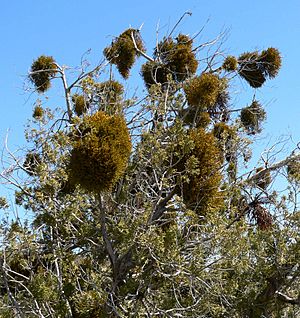Juniper mistletoe facts for kids
Quick facts for kids Juniper mistletoe |
|
|---|---|
 |
|
| juniper mistletoe in host tree | |
| Scientific classification | |
| Genus: |
Phoradendron
|
| Species: |
juniperinum
|
| Synonyms | |
|
Phoradendron ligatum Trel. |
|
Phoradendron juniperinum, also known as juniper mistletoe, is a type of flowering plant. It belongs to the sandalwood family. This plant grows naturally in the southwestern United States and northern Mexico. You can find it in different kinds of forests and woodlands.
Juniper mistletoe has been seen in many places. These include California, Nevada, Arizona, New Mexico, Oregon, Utah, and Texas. It also grows in the Mexican states of Chihuahua and Sonora.
This mistletoe is a parasite. This means it lives on other plants to get its food. It mostly grows on different types of juniper trees. Some of these include Utah juniper, Rocky Mountain juniper, and western juniper.
Contents
What Juniper Mistletoe Looks Like
Juniper mistletoe is a shrub. It grows many yellow-green branches. These branches can be 20 to 40 centimeters long. They grow straight up or spread out from a woody base. This base is where the mistletoe attaches to its host tree.
The plant uses its connection to the host tree to get water and nutrients. It taps into the tree's xylem, which is like the tree's water pipes. The branches are smooth and have flat, scale-like leaves.
How Juniper Mistletoe Gets Food
Juniper mistletoe is a hemiparasitic plant. This means it is a partial parasite. It has some chlorophyll, which is the green stuff in plants. This allows it to make some of its own food using sunlight. But it still needs the host tree for water and some nutrients.
Reproduction and Life Cycle
Juniper mistletoe plants are dioecious. This means there are separate male and female plants. Male plants produce male flowers, and female plants produce female flowers. These flowers grow in small, bumpy clusters.
After the female flowers are pollinated, they grow into shiny, light pink berries. Each berry is about 4 millimeters wide. Birds enjoy eating these fruits. When birds eat the berries, they later excrete the seeds. The undigested seeds then land on tree branches. If the conditions are right, these seeds can sprout and grow into new mistletoe plants.
Traditional Uses of Juniper Mistletoe
Many Native American tribes have used juniper mistletoe for a long time. They used it for different purposes. Sometimes, they made teas from it. Other times, they used it as a food source.
The Zuni people, for example, used this plant in traditional medicine. They would make a special liquid from the whole plant. This liquid was used to help with stomachaches. They also used it to help muscles relax during childbirth. After childbirth, a simple or mixed liquid from the twigs was used to help stop bleeding.
See also
 In Spanish: Phoradendron juniperinum para niños
In Spanish: Phoradendron juniperinum para niños

